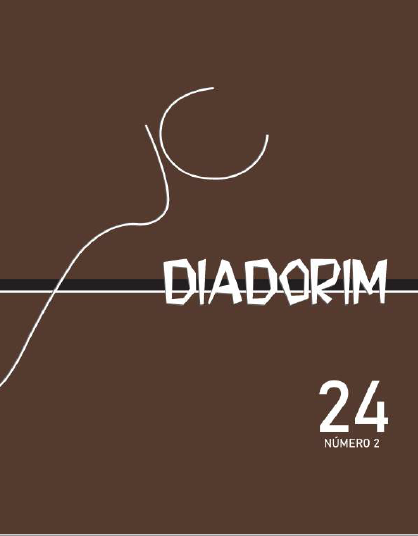A CONSTRUÇÃO DA MULHER-SUJEITO A PARTIR DOS DIÁLOGOS ENTRE ADÍLIA LOPES E PAULA REGO
DOI:
https://doi.org/10.35520/diadorim.2022.v24n2a51095Keywords:
Adília Lopes, autoria feminina, crítica feminista, Paula Rego, poesia, trabalho.Abstract
Este artigo propõe uma análise comparativa entre o livro A mulher-a-dias (2002), de Adília Lopes, e as séries produzidas ao longo dos anos 2000, de Paula Rego, como a Mulher-cão, a partir de recursos estéticos e linguísticos compartilhados pelas duas autoras. A presença da influência de Paula Rego na obra da poetisa portuguesa é anunciada já no prefácio da sua obra. Nesse sentido, analisaremos à luz da intertextualidade e da autoria feminina os elementos culturais e narrativos que ecoam em ambas produções.
References
ADORNO, T. W. Notas de literatura. São Paulo: Editora 34, 2012.
ALMEIDA, L. P. de. Paula Rego na capela do Palácio de Belém, em Lisboa. Agulha Revista de Cultura, n.º 115, julho de 2018. Disponível em: http://arcagulharevistadecultura.blogspot.com/2018/07/lilian-pestre-de-almeida-paula-rego-na.html
AMARAL, A. L.; SANTOS, M. I. R. de S.. Sobre a “escrita feminina”. Oficina do CES (Centro de Estudos Sociais) n.º 90, abril de 1997. Disponível em: Acesso em 12 de janeiro de 2021.
ARRUDA, L. A representação da figura feminina em Paula Rego. Arte & Sociedade, Actas das Conferências, p.156-161, 2011.
BARRENO, M. I.; HORTA, M. T.; COSTA, M. V. da. C. (org.). Novas cartas portuguesas. Alfragide: D. Quixote, 2010.
BALTRUSCH, B. Adília Lopes: traducir entre la entropía y la subversión. Lectora, vol. 14, pp. 231-249, 2008.
BEAUVOIR, S. de. O segundo sexo: fatos e mitos - v. 1. Trad. Sérgio Milliet. Rio de Janeiro: Nova Fronteira, 2016.
BELTING, H. Likeness and Presence, A History of Image before the Era of Art. Chicago: University of Chicago Press, 1994.
COMPAGNON, A. O demônio da teoria: literatura e senso comum. Trad. Cleonice Paes Barreto Mourão e Consuelo Fortes Santiago. Belo Horizonte: UFMG, 2010
KATZ, M. Marian Motion: Opening the Body of Vierge Ouvrante. In: ZCHOMELIDSE, N.; FRENI, G. Meaning in Motion: The Semantics of Movement in Medieval Art. Princeton University Press, 2011.
KLOBUCKA, A. O formato mulher: a emergência da autoria na Literatura Portuguesa. Coimbra: Angelus Novus. 2009.
LOPES, A. Dobra – Poesia Reunida. 2ª ed., Porto: Assírio & Alvim. 2014.
LOPES, S. R. A anomalia poética. São Paulo: Chão da feira, 2019.
MACEDO, A. G. Paula Rego e o poder da visão: a minha pintura é como uma história interior. Lisboa: Cotovia, 2010.
MACEDO, A. G.; AMARAL, A. L. (org). Dicionário da Crítica Feminista. Lisboa: Edições Afrontamento, 2005.
MOI, T. “I am not a woman writer”. About women, literature and feminist theory today. Feminist Theory. vol. 9(3), p. 259–271, 2008.
NOCHLIN, L Women, art and power and other essays. London/New York: Routledge, 1988.
NOCHLIN, L Por que não houve grandes mulheres artistas. São Paulo: Edições Aurora, 2016.
ROSENGARTEN, R. Contrariar, esmagar, amar. A família e o Estado Novo na obra de Paula Rego. Lisboa: Assírio & Alvim, 2009.
VAQUINHAS, I. História das mulheres e de género em Portugal: Horizontes temáticos e desafios atuais. Faces de Eva. Estudos sobre a Mulher, n. extra. Lisboa out. 2019. Disponível em:
http://www.scielo.mec.pt/scielo.php?script=sci_arttext&pid=S0874-68852019000200005
VICENTE, F. L. A arte sem história: Mulheres e cultura artística (séculos XVI - XX). Lisboa: Babel, 2012,
TAVARES, M. M. P. F. Feminismos em Portugal (1947-2007). 2008. Tese (Doutorado em Estudos sobre as Mulheres, História das Mulheres e do Gênero) – Universidade Aberta de Lisboa, Lisboa, 2009.
Downloads
Additional Files
Published
Issue
Section
License
Copyright transfer -- Authorization to publication
If the submitted article is approved for publication, it is already agreed that the author authorizes UFRJ to reproduce it and publish it in Diadorim: revista de estudos linguísticos e literários, the terms "reproduction" and "publication" being understood as defined respectively by items VI and I of article 5 of Law 9610/98. The article can be accessed both by the World Wide Web (WWW) and by the printed version, with free consultation and reproduction of a copy of the article for the own use of those who consult. This authorization of publication is not limited in time, and UFRJ is responsible for maintaining the identification of the author of the article.

The journal Diadorim: revista de estudos linguísticos e literários is licensed under a Creative Commons Attribuition-NonCommercial 4.0 International (CC BY-NC 4.0).

